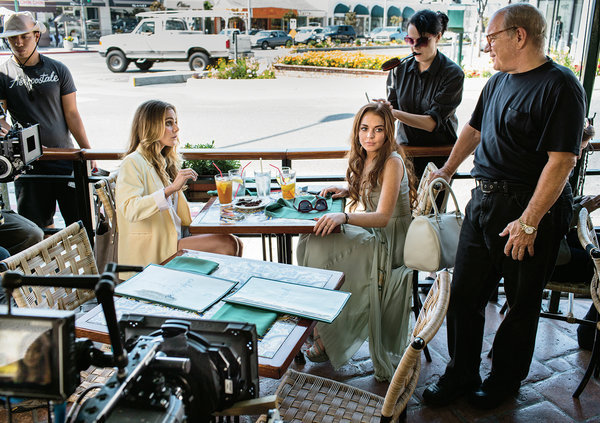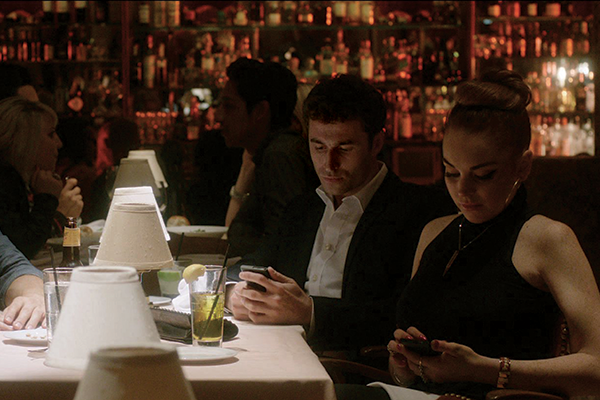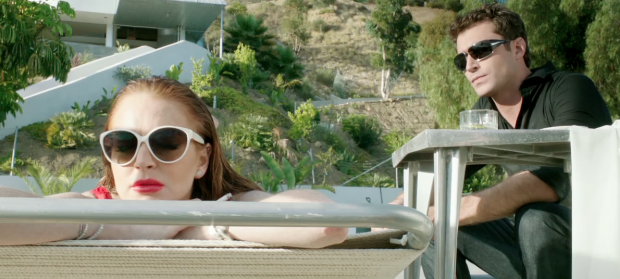The current economic model has been tough on Paul Schrader, whose preference for dark, old-fashioned, and uncompromised filmmaking is exactly the combination most investors would balk at — despite penning generation-defining screenplays for Martin Scorsese and a wide, thrilling filmography of his own. When dried-up fund after dried-up fund caused opportunities to wither away, he and author Bret Easton Ellis — a duo who had, before, meant to partner on a shark movie, Bait — turned toward Kickstarter to fund The Canyons, an erotic thriller that, in starring Lindsay Lohan and porn figurehead James Deen, had attracted more attention for its production than the final result itself.
Now that it’s in theaters and on VOD (review here), we had the pleasure of speaking with the legendary writer-director — more about his process than outside publicity, however. Below, Schrader opens up about differences in intent between he and Ellis, assembling a team through the Kickstarter model, and how his cinematographer wasn’t keen on a key influence.
The Film Stage: First off, how did you like the move from celluloid to digital?
Paul Schrader: Oh, I thought it was great; I think the Alexa Pro is a great camera. This film certainly could not have been made under old-time economics — you know, this is a micro-budget film — and we had just enough money to make the film. We used it well. I loved this Alexa Pro.
Relating to that, the Kickstarter model used to support this production had earned a wealth of attention. Did you ever speak with colleagues in the film industry — asking what they thought about it, and how they felt about you going toward that system?
No, no. I mean, I think the impulse of Bret, I, and [producer] Braxton [Pope], right from the start, was, “Let’s just do this, and let’s not ask anybody’s permission.” And, also — equally importantly — let’s find out if it can be done. Part of the fun of this last year was sort of exploring an incognito media and getting off the boat, heading inland, and forging your way through. So, it was a very invigorating experience, that way, and nothing about the film was done in a way I had done before — not the conception, not the casting, not the financing, not the making, the promotion, the distribution. And, so, it’s been a very revitalizing experience.
Speaking of new directions, I was curious when you had said, in an earlier discussion, that Bret’s screenplay was not in “your world,” and is actually exploring “much colder” terrain than you would prefer. When it came to the hands-on process of directing, how did you find “your world” amidst Ellis’ screenplay?
Well, I mean… I think the film is more Bret than me. Of course Bret thinks it’s more me than him, and I guess that’s the hallmark of a good collaboration. I let Bret be my tour guide into this world: I’m a generation away from him, and he’s a generation away from these characters. I could not have accessed these characters on my own. I needed him to take me there, and he’s familiar with the Blendr and the Grindr generation — I am not. So, that was that.
Although such a divide exists — and although they’re not your own creation — did you feel a connection to the characters of Christian and Tara, specifically in relation to protagonists you’ve built for decades?
Oh, yes, yes. And, of course, you’re in there, you’re making a movie, and occasionally someone shows you a photo they took on set — and you say, “Wait, who’s that old guy?” And then you say, “Oh, fuck, that’s me!” [Laughs] “What’s that old guy doing on my set?!”
Further down the line of collaboration, having worked with some legendary composers in earlier works — Philip Glass, Giorgio Moroder, and Angelo Badalamenti among them. When it came to The Canyons, what distinguished your turn with Broken Social Scene’s Brendan Canning?
Well, first we had to find somebody who would work for free and who didn’t have a deal — because Brendan owned his own music, and everything he did was at a deferred cost. That’s just the nature of what we were doing. So, you didn’t go to composers — you talked around with people in the music business and you said, “Who might be interested in doing this,” rather than making a list of who’s best. And, then, you start getting some names, and Broken Social Scene was suggested to me.
I liked the variety of their music, and how they keep sort of changing their music. Brendan got excited by it, and so that was that. And, to be honest, I like using first-time composers for movies, because they’re looking at the problem for the first time, and they’re always coming up with sort of interesting solutions. Whereas, if you get an old-time composer who’s done a hundred scores, they’re giving you all of their solutions.
Did this different process of finding a team frustrate you and the hires?
Well, it’s $100 a day, and that’s that. So, you go to friends, and you, sort of, start throwing out your situation and see who responds to it. The people, they have to come to you, because they have to accept the situation when they walk in the door.
Based on your seminal text, it would seem that three cinematic heroes are Ozu, Dreyer, and Bresson, a trio of artists who people might not associate with your latest title. How would you say — if, in any way — their respective bodies of work could have influenced you on The Canyons?
I wouldn’t say this has any of that in it. My primary visual influence is Bertolucci and The Conformist, and there is some of that in this — but, you know, film style has changed. It’s now possible to mix and match all kinds of things: you can take a Bertolucci scene and put it next to a Cassavetes scene, next to a Haneke scene, and it’ll all merge and work together.
In working with your cinematographer, John DeFazio, did you show him The Conformist — more specifically, Vittorio Storaro’s work — and use that, specifically, as his reference point?
Yes, I did, and… [Laughs] and… you know, he didn’t like it! I was sort of shocked. How could anybody not love The Conformist? But, you know, he’s not really a cinematographer. What’s funny is that he’s from the world of visual arts, and so this was kind of an experiment for him, too.
How do you find what Bret’s scenes required, in terms of shooting style?
Well, so much of it had to do with that house in Malibu, which we got through Kickstarter. It was a fabulous house; there’s not a bad angle in that house. And, after the first day of shooting in that house, I said to the cinematographer, “I’m shooting Gigolo again. It’s this damn house. It’s just driving me into all those kinds of angles and movement.”
We had a feature looking at Hardcore, American Gigolo, Auto Focus, and The Canyons, as far as your cinematic relationship with Los Angeles goes. How do you feel an approach to filming and working in the city has changed, creatively?
Not that much. I mean, this was meant to be a very clean Los Angeles set — the Bret Easton thing. There’s hardly any decor in any of these places, and I felt that, in other adaptations of Bret’s work, it tried too hard to bring in the color gels. And so I went more with a white light — the sun-lit feel.
Do you respond to the overlaps that might be found in these Los Angeles-set works?
How so?
For one thing, all the films listed deal, in part, with sex.
Yeah, yeah, I know. But, then, it’s kind of hard to make a movie that doesn’t. [Laughs] You’ve only got two guns on your holster — one is violence, and the other is sex.
To that end, when working with Deen, a porn star, did you find much of a difference in his on-set manner, as opposed to past experiences with more “traditional” actors?
No, no, not at all. First of all, he’s far more professional than any actor I’ve ever dealt with — I mean, if you can have a Calvinist work ethic in pornography, he has it. There’s a punctual indulgence: he’s prepared and, also, very tolerant. He’s seen a lot of high-strung behavior in his years. I was fortunate, because Lindsay is a high-strung person. But James Deen had it all, and he was a saint, in that way. We had all the same discussions you have with any actor, and James is very wide-open about what he does for a living and the fact that he wants to keep doing it. But, quite quickly, you forget that and it just becomes about the character.
Did all this attention surrounding The Canyons help with The Dying of the Light, your Nicolas Cage-starrer that’s been gaining traction as of late?
No. I mean, I had sold that, and Nic Refn was going to do it, and that eventually came back to me. So, that was sort of “happening.” I met with the Australian producer yesterday — he’s distributing Canyons in Australia — and the fact that I’ve had this year of training in new media pleased him greatly, because everyone’s trying to figure out how to promote films in this fractured social media landscape.
Good luck with Light. We’re very much looking forward to that one.
[Laughs] Oh, so am I.
The Canyons is now in theaters and on VOD.





